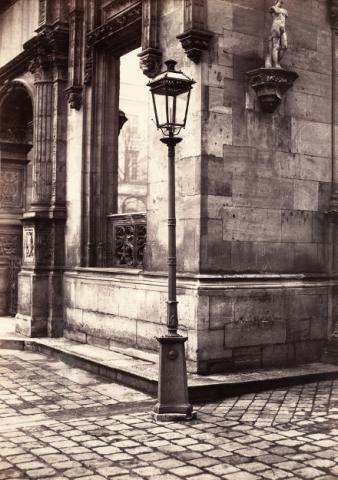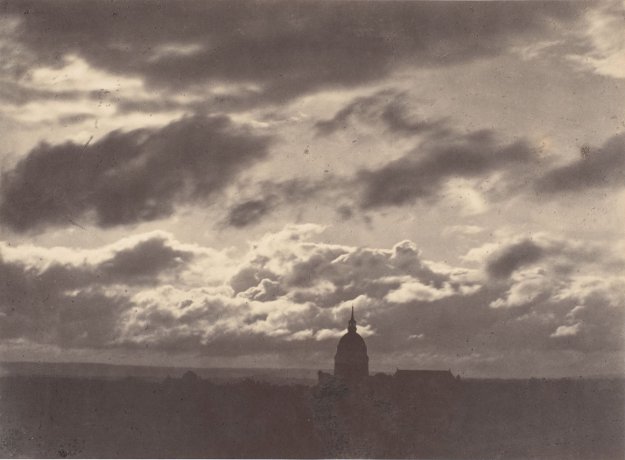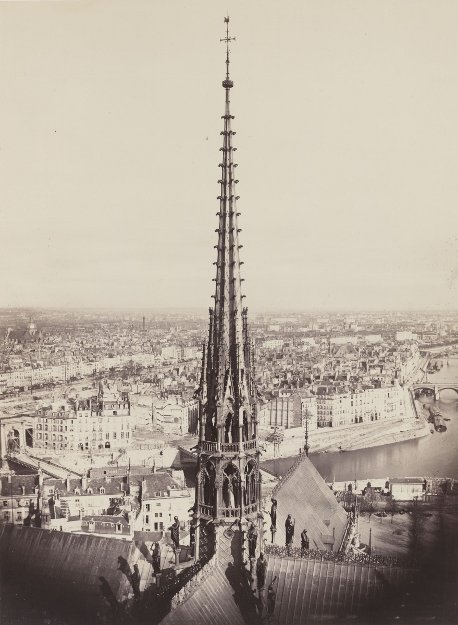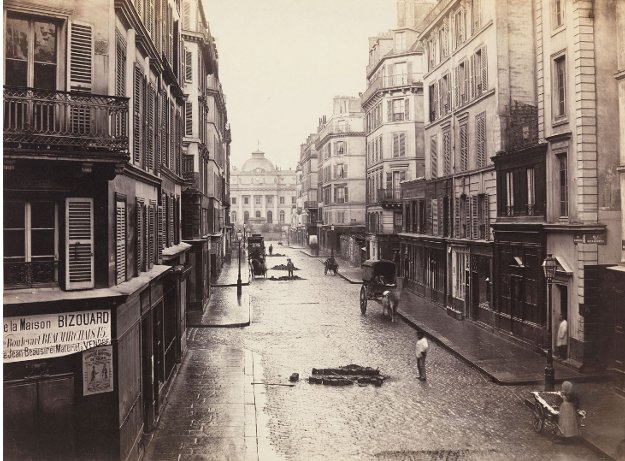The Photographs of Charles Marville – The Eyes of Paris

Let’s face it—Paris is probably one of the most photographed places on the planet, so what’s all the fuss about one more photographer adding his own indelible images to the list? A reasonable point of view perhaps, but when the Metropolitan Museum of Art’s new exhibit, Charles Marville: Photographer of Paris is the subject, it’s worth a great deal of fuss. Capturing the picturesque streets and alleyways, monuments and churches, lampposts and clouds of the City of Light in the mid-1800s was no easy assignment, but Marville was the man—maybe the only one—for the job.
Born in 1813 in the city he was destined to immortalize, his real name was Charles-Francois Bossu or “hunchback,” but there all similarity ended. By 1832, calling himself Marville, the young man who cut his teeth on wood engravings and illustrations for the popular press had begun to take photographs in earnest. Only a few years earlier, Fox Talbot had invented salted-paper prints and Marville quickly mastered the technique, demonstrating an extraordinary delicacy and acuity of detail.
Marville was best known for his appointment as the official photographer for the radical modernization project launched by Emperor Napoleon III and his chief urban planner, Baron Georges-Eugene Haussmann. Yet, this extraordinary artist in a new and problematic medium brought the same care he showed for documenting the soon-to-be-demolished Old Paris to the landscapes of the Bois du Bologne, the haunting caryatides in the Louvre and the lampposts that lit up Parisian arrondissements where city-dwellers had once been afraid to step outside without flaming torches to guide their way. It is to the credit of the National Gallery of Art in association with the Met’s own curators, that a healthy portion of the 100 and some images on view are from a wide spectrum of Marville’s passions, not just the estimable array of streets and structures that would vanish from the world if not its conscience.
A few images of the many in this prior category worth mentioning include a number from the Notre Dame Cathedral, ie., The Roofs of Notre Dame from the Gallery of Towers which shows elephants and tigers topping the nearby spires. Gargoyles aside, it’s a veritable circus of creatures inhabiting this imposing structure. A young Marville has even posed himself in front of La Porte Rouge, The Red Door, Northern Portal (1851), an imposing entrance for the clergy. He appears very much the dandy during these shooting sessions, having set up the composition then left the assistant to time the exposure. Another such evocation of subject matter, South Portal of the Chartres Cathedral, shows the effect that the interplay of light and shadow can have on such a scene.

Close-up portraits are a rarity, but a picture of his studio assistant, Charles Delahaye, is noteworthy. Resting on his elbow, dark locks of hair spiking helter-skelter from his head, he resembles denizens of New York’s East Village dwellers today. Among Marville’s lamppost series, a beautifully ornate candelabra on the Avenue de l’Opera catches the eye, as well as a series of lampposts at the entrance to the Ecole de Beaux-Arts.
As for a natural affinity for nature which shines through this exhibit, his cloud studies are all the more remarkable for the difficulty inherent in rendering them at all. A photographer may have had to expose two images, one for the ground landscape and another for the sky, the latter often whited-out otherwise or deliberately ignored. In some instances, clouds actually would be painted onto the negative. Obviously, Marville’s tireless curiosity paid off in the results. It’s a fair speculation that the early 20th century cloud photographs by Edward Steichen were inspired by an exposure to Marville’s works.
An expansively wooded preserve, otherwise known as the one and only Bois de Boulogne, came under the Emperor’s all-seeing eye—quickly becoming a top priority for transformation. Marville’s reflections of the area’s surrounding trees in water, with a resting canoe, as in The Prefect’s Pond, could have served as an early inspiration to none other than Claude Monet in his Giverney garden and pond paintings. The Longchamps windmill was captured by Marville as well in the Bois, the last remnant of the 13th century abbey of the same name.

The Top of the rue Champlain features a young boy seated on the rise of a hill in the 20th arrondissement, overlooking a cluster of desolate buildings. It manages in its stillness to transcend the rubble below, creating a melancholy sense of isolation in the viewing.
As for the impressive collection of photographs done during Baron Haussmann’s urban leap into modernity, there are many images to ponder or single out. Every aspect of urban civilization was fair game, from the construction of the Paris Opera to the issue of sanitary urinals. But first, it’s worth noting that the plan underway, referred to as “piercings” was a two-step process of tearing down the ancient structures and streets in question, then creating wide arteries for the boulevards of his dreams. We can be thankful that he had the foresight to hire Marville to document what would soon be lost forever.
Marville had an approach in subject matter that allowed for a measure of idiosyncratic detail. Tanners are seen taking a break from their hide scraping as they lean against crumbling pillars soon to disappear. One can almost smell the stench from the watery, putrid run-off. This we are told by detailed wall captions was a section of the Bievre, a tributary of the Seine that now runs underground. Medieval merchant’s quarters and old print houses with their peeling posters advertised everything from baths, mechanical beds, and umbrellas to the photography of a certain Pierre Petet. In a few instances, there is an almost haunting vapor-like blur where the exposure was too slow to capture the milling throng of passers-by or horse-drawn carts.

There’s a sweet, lingering sadness to be had viewing this vanished world, as if a ghost had crossed one’s path in the course of our wanderings. But it’s a caring spirit, maybe Marville himself, giving us a fresh look into a very real past.
Paris as Muse
In an adjacent room of the exhibit, the visit is enhanced by a small but intriguing series of 40 photographs, Paris as Muse, created over the first 100 years of documenting the magical city. Focusing primarily on architectural views and street scenes, it still manages to convey the poetic approach employed by visiting or resident photographers. Wall quotes help to signify the changing times, ie., Gertrude Stein’s quote from 1940, “Paris was where the 20th Century began.” Another from 1918, by James Thurber, suggests the total rush of one’s initial exposure to the place: “Paris is a seminar, a post-graduate course in everything.”
Gyula Halasz, aka Brassai, for those who are exposed to this photographer of the demimonde for the first time, is always fascinating and revelatory for his times. One such example shows us a string of street girls, possibly prostitutes, poised in eye masks in languorous “devil may care” poses. Such pictures were typical of his legendary collection, “Paris by Night” from 1933. Another shows us a man stationed in the fog of night which could have served as an outtake from the final film scene from Casablanca. Ilse Bing’s lamppost at night is also a moody delight.
Andre Kertesz , another Hungarian émigré, was a master of composition and contrast. We see a disinterested Parisian woman resting on a bench with a splashy row of Dubonnet posters featuring their iconic little man as subject in the background. A more signature example of his genius is a photograph shot from above, presumably at the top of the Eiffel Tower’s base. The shadows of its grillwork spill over an ant-like arrangement of visitors below.

No exhibit from this time period would be complete without Atget’s wonderful eye on display. Never one to make people a priority in his compositions, the delicacy of his landscapes, urban and otherwise, prove him the worthy descendant of Marville’s own pair of eyes. The resultant quietude is evident in a row of empty café chairs or a window of mannequins along the Avenue des Gobelins. Atget’s corsets window along the Boulevard de Strasbourg is also worth a peek.
This is an exhibit worthy of being experienced before its May 4th closing date.
Author Bio:
Sandra Bertrand is Highbrow Magazine’s Chief Art Critic.






























































































































































































































































































































